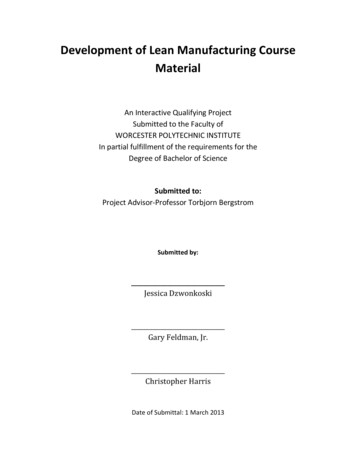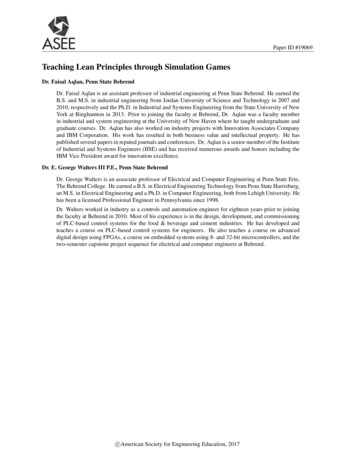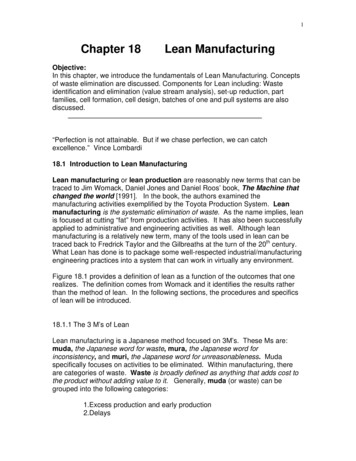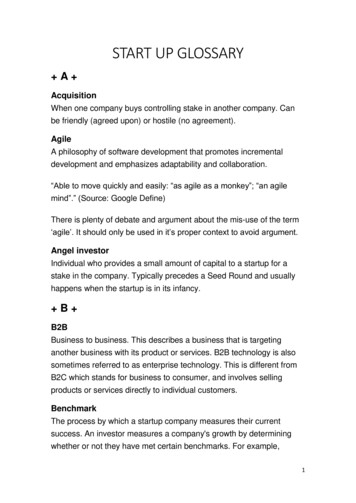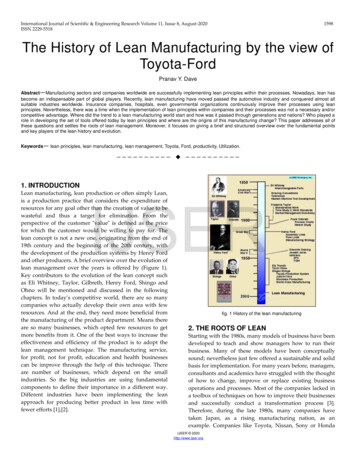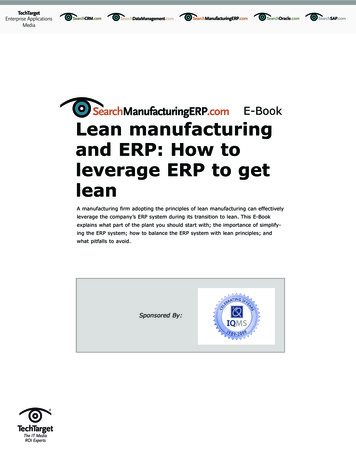
Transcription
Proceedings of the International Conference on Industrial Engineering and Operations ManagementBangkok, Thailand, March 5-7, 2019The Application of Lean Manufacturing to ReduceSetup Time of a Printing ProcessKasarin ChivatxaranukulAeronautic Engineering,Vincent Mary School of Engineering,Assumption University, Thailandkasarinch@gmail.comAbstractIn today’s highly competitive world, industries are forced to find ways to survive by increasing efficiency andreducing costs. As one of several industries that are facing the challenges, the printing industry is threatened bycompetitions both among companies in the industry and technological threats like multimedia, e-books, etc., leadingto the reduction in sales prices, higher competitions, and lower demands. This accentuates the need for companiesto cut costs and improve productivity. The concept of Lean Manufacturing revolves around reducing wastes.Reduction of wastes can lead to significant increase in productivity and reduction in costs. Thus, Leanmanufacturing is one of the techniques that can potentially be applied to provide means for companies in theindustry to survive. This research studies the analysis of setup time reduction of a printing process using a leanconcept called Single Minute Exchange of Die (SMED). Main strategy for SMED involves identifying setupactivities, trying to convert the internal activities to external activities, and reducing activity times. The analysesof setup activities are conducted and a methodology to reduce standard setup time is presented. Although data usedin this research pertain to the company used as a case study, the approach can be applied to a printing process ingeneral.Keywordslean production, lean manufacturing, Single Minute Exchange of Die, setup time reduction1 IntroductionAmidst the global decline of economy, companies are forced to find ways to survive by cutting costs, increasingefficiencies, and reducing losses among several other things. Among several strategies, Lean Production is one thathas been implemented to a variety of industries in order to reduce costs or so called wastes and has allowed companiesto increase their productivity and provide surviving leverages (Resende et al. 2014).The concepts of lean emphasize elimination or removal of wastes, which have been traditionally categorized intoseven types:- over production, transportation or unnecessary movements of materials, waiting time, processes (overprocessing or incorrect processing), inventory, motion, and defective goods (Elbert 2012). In the perspective of leanproduction, wastes involved in production activities are typically activities that do not add value to the product. Theelimination of wastes leads to reduction of costs and subsequently results in more efficiency and higher profits for theorganization.1.1. Setup time reductionSetup or changeover time is one element that can have a significant impact on overall production time or cycle time.It has been regarded by firms as one of the most expensive costs in manufacturing (Holweg 2006). Reducing setuptime can lead to the reduction of cycle time as well as open up more capacity for production. This, in turn, leads to the IEOM Society International89
Proceedings of the International Conference on Industrial Engineering and Operations ManagementBangkok, Thailand, March 5-7, 2019reduction of both tangible and intangible costs. An example of intangible costs is the opportunity cost from not beingable to receive or produce for more orders when the machine or workforce is occupied. Examples of tangible costsinclude labor and overhead costs involved with longer production time.In make to stock situations, manufacturers usually opt to produce large quantities or lot sizes in order to minimizesetup costs. This, however, results in large inventories, which is considered as wastes. Thus, in view of leanmanufacturing, reducing setup times is one key element for improvement. The reduction of setup times posesopportunities to reduce lot sizes and, consequently, inventory levels. In make to order production environments, whereeach lot produced is tailored to the customer’s design, the impact of reduction of setup times will be even moresignificant as a setup is required for every change of jobs or orders.1.2. SMEDSingle Minute Exchange of Die (SMED) developed by Shingo, S. in 1985 (Shingo 1985) is a lean principle thatfocuses on reducing setup time. SMED was originally introduced in the automotive assembly industry and later hasbeen extended to other industries. The process in implementing SMED involves the identification of setup activitiesand separating them into external and internal activities. Internal Activities are those that must be done on the machineor when the machine is stopping. External activities, on the other hand, are activities that can be done without stoppingthe machine. Converting as much of internal activity time to external activity time is a crucial step to improving thesetup time.1.3. Printing Process and Setup timeThis research studies offset printing process, which is a process in book manufacturing and commercial printings.Printing can be considered as make-to-order production since each job has its own design and requirements. Producingone book requires printing several impressions. Typically, an impression of printing is a set of eight pages that requiresone set of plates or dies. To produce one book, several setups is required with thicker books requiring more setuptimes. For example, a book with 96 pages comprises 12 impressions. Transitioning from one impression to anotherrequires a change of plates as well as color matching process which is unique to every printing impression. The timerequired to setup one impression of print can be variable depending on the job and several conditions such as machinecondition, the condition or paper, and materials.On average, about 60-70 minutes is required for setup from the end of previous job to approval of printing of the nextjob. Depending on the lot size or printing quantity, the significant setup time can contribute to more than 50% of totalprinting time (including setup) for each impression, especially for the jobs with smaller lot sizes. The smaller thequantity, the higher impact setup time has on total printing time. If setup time can be reduced, even a matter of a fewminutes, the accumulative results can be significant in the contribution to the reduction of costs and increase inproductivity.Although SMED theoretically attempts to reduce setup time to less than 10 minutes (Dave and Sohani 2012) whichdoes not seem applicable to the setup of printing process initially, the concept of SMED can still be applied to improvesetup time of printing impression even though it cannot be reduced to less than 10 minutes.2 Literature ReviewConsiderable number of researches and papers have been dedicated to the study of lean production and its application.The works can be separated into literature reviews and analyses and applications of lean principles.Gupta and Jain (2013) conducted a thorough literature review of lean manufacturing. They separated research worksand studies in the field of lean manufacturing into the studies of lean philosophy, surveys, case studies, as well asresearch works that address the barriers to implementing lean and competitive benefits of lean manufacturing. Sundar,Balaji and SatheeshKumar (2014) provided a review on different implementation techniques of lean manufacturing. IEOM Society International90
Proceedings of the International Conference on Industrial Engineering and Operations ManagementBangkok, Thailand, March 5-7, 2019The work was conducted by means of literature survey. Prajapati and Despande (2015) reviewed different leanprinciples and techniques for reducing cycle time.Other works related to the implementation of lean manufacturing include Lodgaard et al. (2016), AlManei, Salonitisand Xu (2017), and Moeuf et al. (2016). Lodgaard et al. (2016) studied the barriers to successful implementation oflean strategies. Similarly, AlManei et al. (2017) identified obstacles and challenges in the successful implementationof lean and the frameworks required for success for Small and Medium Enterprises (SMEs). Moeuf et al. (2016)explored the difficulties experienced in the implementation of lean production.This research work focuses on reduction of setup time, which is believed to be a significant contribution to thereduction of cycle time and, thus, reducing waste. A relevant lean manufacturing approach that focuses on setup timereduction is Single Minute Exchange of Die (SMED). Relevant previous research works pertinent to setup timereduction by the implementation of SMED include Esa, Rahman and Jamaludin (2015), Joshi and Naik (2012), Jagtapet al. (2015), Abraham, K.N. and Motwani (2012), Simoes and Tenera (2010), Resende et al. (2014), and Ferradasand Salonitis (2013). Joshi and Naik (2012) provided a literature review of SMED. Abraham et al. (2012) appliedSMED to reduce setup time in a stamping line. Smimoes and Tenera (2010) applied SMED to improve setup time ina press line. Azizi and Manoharan (2015) studied reducing lead time as opposed to only focusing on setup time usingSMED and Value Stream Mapping (VSM).3 MethodologyThe process of SMED can be summarized as follows (Joshi and Naik 2012, Jagtap et al. 2015):Step 1: Analyze the setup operationsStep 2: Separate internal and external setup activities.Step 3: Convert internal setup activities into external activitiesStep 4: Shorten internal setup and external setup activitiesConsiderable amount of work pertaining to the application of lean has been dedicated to the automotive industry. Tothe author’s knowledge, no formal work has been published regarding the analysis of setup operations in the printingindustry. This research discusses the analysis of activities involved in the setup of printing impressions, the separationof the activities into internal and external activities, and the conversion of internal setup into external setup activities.The analysis of setup operations was performed through observation and gathering information from operators’ timesheets over the course of three years as maintained by the company. Activities were then broken down into internaland external setup activities and standard time (the time required by an average skilled operator to perform a specifiedtask under normal conditions using a prescribed method) for each activity was obtained by analyzing the time sheetsand observations.4 Settings and AssumptionsThe printing process selected for this research is four color offset sheet-fed printing process performed on a semiautomated printing machine with no extra equipment for color reading. The printing machine selected has acomputerized system to read and memorize the density of color dots on the mold in order to digitally preset the levelof ink that each ink key will exert.The setup time under study is defined as the transition time from the finish of one printing job to the finish of colorsetup for the next job. “Job” represents an impression which is printing using the same set of 4 molds for 4 processcolors for printing 8 pages of standard A4 sized.5 Applying SMED to Printing Process Setup IEOM Society International91
Proceedings of the International Conference on Industrial Engineering and Operations ManagementBangkok, Thailand, March 5-7, 2019Step 1: Analyze the setup operationsInitially, the activities involved in the setup of a printing impression has not been formally broken down and analyzed.Without analyzing the activities involved in the setup process, it is impossible to improve the setup time.It is essential to break down setup operations into small steps and identify time required for each setup activity or step.The analysis of setup operations was performed by observation and recording, which led to the breakdown of setupactivities into small steps.Activities required from finishing of the previous printing job to finishing color setting for the next job can be brokendown into the following:1.2.3.4.5.6.7.8.Washing of pervious set of printing blankets.Filling ink in each of the four ink trays.Preparing for plates (molds) of the next job.Putting in four plates into four printing units (4 units for 4 process colors).Setting paper size.Putting paper stack in the feeding station.Setting the machine ink keys to control the level of ink exerted from each zone.Adjusting ink zones and machine settings to adjust colors.This breakdown enables the analysis of which elements of the setup operations contribute to this considerable setuptime that can possibly be improved. Standard time for each broken down activity has to be determined. The standardtimes are obtained by averaging recorded times of each activity under normal circumstances. Table 1 lists standardtime used in each setup activity.Step 2: Separate internal and external activities.The analysis of activities discussed in step 1 results in the separation of internal and external activities as shown inTable 2.Table 2 Separation of setup activities into internal and external activitiesActivities1234567Washing of pervious setof printing blankets.Filling ink in each of thefour ink trays.Preparing for plates(molds) of the next job.Putting in four platesinto four printing units(4 units for 4 processcolors).Setting paper size.Putting paper stack inthe feeding station.Setting the machine inkkeys to control the levelof ink exerted from eachzone.StandardTime(min.)8Internal5 External 10 20 33 15 IEOM Society International92
Proceedings of the International Conference on Industrial Engineering and Operations ManagementBangkok, Thailand, March 5-7, 20198Adjusting ink zones andmachine settings toadjust colors.15 Activities 1 and 4 are require the machine to be performing the specified functions. Activities 5, 7, and 8 require theoperator to enter commands onto the computer that controls the printing machine and the machine performs the settingaccordingly. These are internal activities that cannot be performed unless the machine is not operating. Therefore,they are categorized as internal activities. Activity 3, preparation of plates is performed by an operator and does notrequire work to be done on the machine, thus, categorized as external. Activity 2 is performed manually by theoperator but must be performed on the ink trays which are parts of the machine. Therefore, it is initially categorizedas internal. Activity 6 can only be performed when the machine is not running and also categorized as internal.As can be seen from Table 2, only 1 out of 8 activities (Activity 3: preparing for plates of the next job) is initiallyperformed externally. This means that the setup process requires the machine to be stopped for 87.5% of the setupactivities. Following the standard activity times in Table 2, these internal activities accumulate to 69 minutes ofmachine time.Internal activities that can be transformed into external activities are analyzed and discussed in the next step.Step 3: Convert internal setup activities into external activitiesFrom Table 2, out of seven activities that are internal, three activities can be transformed into external activitieswithout involving investments in machine replacement with higher technology. These activities that can be changedinto external activities, resulting in the reduction of setup time are:1.2.3.Activity 2: Filling ink in each of the four ink traysActivity 5: Setting paper sizeActivity 7: Setting machine ink keys to control the level of ink exerted from each zone.Filling of ink into ink trays can be changed from internal to external by utilizing ink pipe feeding which allow forautomatic pumping of ink to feed the trays. The process can also be done without having to invest in installing inkfeeding system by simply changing the way operators perform work. Instead of waiting until the end of the job tofeed ink for the new job during setup, operators can simultaneously fill the ink while the current job is still running.Setting of paper size for the next job can also be done while the machine is working on the current or previous job byusing a presetting function, which is already present in the printing machine but not currently utilized. Similarly,setting machine ink key levels can also be done prior to finishing the current job. However, these changes movingfrom internal to external activities present challenges as they require operators to work more effectively. This willinvolve a certain level of motivating, incentives, change of mindsets, and monitoring. Provided that these can be done,the breakdown of internal and external setup activities can transition from those presented in Table 2 to those in Table3. Three more activities can be shifted to external activities.Table 3 Separation of setup activities into internal and external activities after change12345ActivitiesWashing of pervious setof printing blankets.Filling ink in each of thefour ink trays.Preparing for plates(molds) of the next job.Putting in four plates intofour printing unit (4 unitsfor 4 process colors).Setting paper size.Internal External IEOM Society International93
Proceedings of the International Conference on Industrial Engineering and Operations ManagementBangkok, Thailand, March 5-7, 2019678Putting paper stack in thefeeding station.Setting the machine inkkeys to control the level ofink exerted from eachzone.Adjusting ink zones andmachine settings to adjustcolors. Step 4: Shorten internal setup and external setupsIn addition to transforming internal activities into external activities, SMED can also benefit from the improvementor shortening of each activity time. A further analysis yields a result that one activity, although cannot be changedfrom internal into external activity, can be managed such that the setup time reduces. This activity is Activity 6, whichis the activity of putting a paper stack in the feeding station. Although putting a paper stack in the feeding stationrequires the machine to stop, setup time can be reduced by performing this activity in parallel with other setup activitieslike washing of previous set of printing blankets. Operating more than one activity simultaneously, however, requiresadjustments which may involve increasing the number of operators as a different operator is required in putting thepaper stack in the feeding station while other operators engage in other setup activities. This may be conducted withoutthe need to increase the number of operators if current operators are motivated and utilized efficiently.6 ResultsThe results of applying SMED to the setup of a printing process are shown in time as shown in Table 4. By convertingidentified internal activities to external activities, 23 minutes of standard setup time can be reduced. Another 3 minutescan be reduced by performing one internal activity in parallel with other internal activities simultaneously. The totalreduction in setup time as shown in Table 4 amounts to 26 minutes, which contributes to 37.68% of the initial setuptime.Table 5 Results of SMED application to the printing process setup1234567ActivitiesWashing of pervious setof printing blankets.Filling ink in each of thefour ink trays.Preparing for plates(molds) of the next job.Putting in four platesinto four printing units(4 units for 4 processcolors).Setting paper size.Putting paper stack inthe feeding station.Setting the machine inkkeys to control the levelof ink exerted from eachzone.Before8 minAfter8 min5 min5 min10 min10min20min20 min3 min3 min3 min3 min15 min15min IEOM Society International94
Proceedings of the International Conference on Industrial Engineering and Operations ManagementBangkok, Thailand, March 5-7, 20198Adjusting ink zones andmachine settings toadjust colors.sum of nonparallelinternal activitiesExternalInternalInternal but Parallel15 min15min6943Assuming that average lot size is 10,000 books and the machine speed is 10,000 sheets per hour, an approximation ontime saving per day can be obtained as shown below.Operating time per day:Production time per one job:8 hours or 480 minutesSetup lot size speedInitial production time per one job 69 60 129 minutesProduction time per one job after improvement 43 60 103 minutesInitially, the total time required for producing one job with lot size of 10,000 is 129 minutes. For an eight operatinghour day, 480 129 3.72 jobs can be produced per day. After the improvement, 480 103 4.66 jobs can beproduced by one machine daily. This contributes to 25.27% increase in production capacity, which can be significant.7 ConclusionThis paper has analyzed the setup of a printing process for book production and applied SMED, a technique in leanmanufacturing, to reduce or improve the setup time. The analysis of setup operations has led to the possibility ofseparating the activities into internal and external activities. Further analysis has been performed to provide ways toreduce the setup time by changing plausible activities from internal to external and by shortening some internal activitytime by performing one activity simultaneously with other internal activities. This research provides solutions thatcan be implemented which results in an increase production capacity by 25.27% on average lot size provided in theassumption of the results section.In practice, however, the success of the implementation depends on several other managerial issues and factors, suchas motivation, operators’ mind sets, and several other factors. This issue has been addressed by previous researchworks including Lodgaard et al. (2016), AlManei et al. (2017), and Moeuf et al. (2016) and is not the focus of thisresearch. Further extension of this research may include a case study of real implementation, a more thorough studyof the impact of setup time reduction on the financial performance, success factors involved in implementing theresults, and further attempts to reduce time used in internal and external activities.8 ReferencesAbraham, A., G. K.N. & K. Motwani (2012) Setup time reduction through SMED technique in a stampingproduction line. SasTech Journal, 11, 47-52.AlManei, M., K. Salonitis & Y. Xu (2017) Lean implementation frameworks: the challenges for SMEs. ProcediaCIRP, 63, 750-755.Azizi, A. & T. a. p. Manoharan (2015) Designing a future value stream mapping to reduce lead time using SMED-Acase study. Procedia Manufacturing, 2, 153-158.Dave, Y. & N. Sohani (2012) Single minute exchange of dies: Literature review. International journal of leanthinking, 3.Elbert, M. 2012. Lean Production for the Small Company. FL, USA: Taylor & Francis Group.Esa, M. M., N. A. A. Rahman & M. Jamaludin (2015) Reducing high setup time in assembly line: A case study ofautomotive manufacturing company in Malaysia. Procedia - Social and Behavioral Sciences, 211, 215-220. IEOM Society International95
Proceedings of the International Conference on Industrial Engineering and Operations ManagementBangkok, Thailand, March 5-7, 2019Ferradas, P. G. & K. Salonitis. 2013. Improving changeover time: a tailored SMED approach for welding cells. InForthy Sixth CIRP Conference on Manufacturing Systems.Gupta, S. & S. K. Jain (2013) A literature review of lean manufacturing. International Journal of ManagementScience and Engineering Management, 8, 241-249.Holweg, M. (2006) The genealogy of lean production. Journal of Operations Management, 420-437.Jagtap, N. S., V. D. Ugale, M. M. Kadam, S. S. Kamble & A. V. Salve (2015) Setup time reduction of machineusing SMED technique and lean manufacturing. International Journal of Advances in Production andMechanical Engineering, 1.Joshi, R. R. & G. R. Naik (2012) Reduction in setup time by SMED: A literature review. Internationa Jornal ofModern Engineering Research, 2, 442-444.Lodgaard, E., J. A. Ingvaldsen, I. Gamme & S. Aschehoug (2016) Barriers to lean implementation: perceptions oftop managers, middle managers and workers. Procedia CIRP, 57, 595-600.Moeuf, A., S. Tamayo, S. Lamouri, R. Pellerin & A. Leilievre (2016) Strengths and weaknesses of small andmedium sized enterprises regarding the implementation of lean manufacturing. IFAC-PapersOnLine, 49, 7176.Prajapati, M. R. & V. A. Despande (2015) Cycle time reduction using lean principles and techniques: A review.International Jornal of Advance Industrial Engineering, 3.Resende, V., A. C. Alves, A. Batista & A. Silva (2014) Financial and human benefits of lean production in theplastic injection industry: an action research study. International Journal of Industrial Engineering andManagement, 5, 61-75.Shingo, S. (1985) A revolution in manufacturing: The SMED system.Simoes, A. & A. Tenera (2010) Improving setup time in a press line - application of the SMED technology. 2010Management and Control of Production Logistics, University of Coimbra, Portugal.Smimoes, A. & A. Tenera (2010) Improving setup time in a press line - application of the SMED methodology.Management and Control of Production Logistics, 297-302.Sundar, R., A. N. Balaji & R. M. SatheeshKumar (2014) A review on lean manufacturing implementationtechniques. Procedia Engineering, 97, 1875-1885.AcknowledgmentsThe author extends appreciation to an anonymous printing company who has provided opportunities to study thisresearch.BiographyKasarin Chivatxaranukul is a lecturer in the department of Aeronautic Engineering at Vincent Mary School ofEngineering, Assumption University, Thailand. She received her B.S. in industrial engineering from SirindhornInternational Institute of Technology, Thammasat University Thailand and her M.S. and Ph.D. from the school ofIndustrial and Systems Engineering, Georgia Institute of Technology, USA. Her research interests include productionmanagement, lean manufacturing, logistics system, supply chain management, production optimization, engineeringmanagement, engineering economics, and decision analysis. IEOM Society International96
The works can be separated into literature reviews and analyses and applications of lean principles. Gupta and Jain (2013) conducted a thorough literature review of lean manufacturing. They separated research works and studies in the field of lean manufacturing into the studies of le
